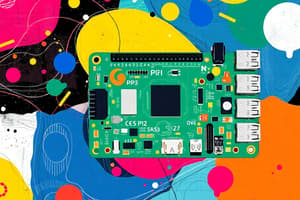Podcast
Questions and Answers
What primary goal does The Big Book of Computing Pedagogy aim to achieve for educators?
What primary goal does The Big Book of Computing Pedagogy aim to achieve for educators?
- Establishing a standardized computing curriculum across England.
- Acting as a resource for tried and tested methods in computing education. (correct)
- Offering comprehensive reviews of all available computing hardware.
- Providing direct solutions to technical computing problems.
What foundational element underpins the pedagogical principles presented in The Big Book of Computing Pedagogy?
What foundational element underpins the pedagogical principles presented in The Big Book of Computing Pedagogy?
- Twelve pedagogical principles developed for the National Centre for Computing Education in England. (correct)
- Anecdotal evidence collected from various computing instructors.
- Mandatory educational guidelines set by the UK government.
- A consensus agreed upon by the Raspberry Pi Foundation's editorial team.
What key objective does The Big Book of Computing Pedagogy share with other Hello World publications?
What key objective does The Big Book of Computing Pedagogy share with other Hello World publications?
- Analyzing the historical development of computing technologies.
- Presenting debates on computing policies.
- Focusing primarily on advanced coding techniques.
- Providing easily digestible research insights linked to practical classroom applications. (correct)
Which of the following represents a primary focus of concept maps as discussed within an educational context?
Which of the following represents a primary focus of concept maps as discussed within an educational context?
How do cross-links enhance the utility of concept maps in education?
How do cross-links enhance the utility of concept maps in education?
What crucial element should educators model when using concept maps with learners?
What crucial element should educators model when using concept maps with learners?
For educators aiming to use concept maps effectively, what alteration to existing practice may be required?
For educators aiming to use concept maps effectively, what alteration to existing practice may be required?
How might an educator leverage 'Story Variables' effectively when introducing programming concepts?
How might an educator leverage 'Story Variables' effectively when introducing programming concepts?
When faced with conflicting viewpoints from IT professionals regarding teaching methods, what should educators prioritize, according to the text?
When faced with conflicting viewpoints from IT professionals regarding teaching methods, what should educators prioritize, according to the text?
In the context of the resource SLUG!, what issue did Sach confront during its creative process?
In the context of the resource SLUG!, what issue did Sach confront during its creative process?
In the context of code instruction, what are learning graphs designed to achieve?
In the context of code instruction, what are learning graphs designed to achieve?
Against which framework or approach might a teacher analyze a computing lesson to determine whether differentiation can be built in at various stages or not?
Against which framework or approach might a teacher analyze a computing lesson to determine whether differentiation can be built in at various stages or not?
According to cognitive load theory, what is the most direct way for educators to reduce the gap between a learner's existing understanding and new computing knowledge?
According to cognitive load theory, what is the most direct way for educators to reduce the gap between a learner's existing understanding and new computing knowledge?
In the context of managing cognitive load, which effect stems from learners needing to handle both essential and redundant information?
In the context of managing cognitive load, which effect stems from learners needing to handle both essential and redundant information?
What is the central aim of the 'Investigate' stage within the PRIMM approach to computing education?
What is the central aim of the 'Investigate' stage within the PRIMM approach to computing education?
What common teaching action does PRIMM's focus on language and talk, as opposed to solely working with code, promote?
What common teaching action does PRIMM's focus on language and talk, as opposed to solely working with code, promote?
What approach should educators avoid to effectively integrate concept maps into their teaching?
What approach should educators avoid to effectively integrate concept maps into their teaching?
Which approach best characterizes the use of non-programming activities in computing education?
Which approach best characterizes the use of non-programming activities in computing education?
What must an educator address to ensure the effective use of PRIMM?
What must an educator address to ensure the effective use of PRIMM?
What does the integration of coding tasks that reflect real-world problems primarily aim to achieve?
What does the integration of coding tasks that reflect real-world problems primarily aim to achieve?
Why should educators reflect on their curriculum, materials, and teaching practices?
Why should educators reflect on their curriculum, materials, and teaching practices?
Flashcards
Concept Map
Concept Map
A graphical tool for organising and representing knowledge.
Focus Question
Focus Question
Specifies what the knowledge represented in a concept map will be about.
VELA concepts
VELA concepts
Non-programming interactives helps students engage with variables, expressions, loops and abstraction
Building a mental model
Building a mental model
Signup and view all the flashcards
PRIMM
PRIMM
Signup and view all the flashcards
Universal Design for Learning (UDL)
Universal Design for Learning (UDL)
Signup and view all the flashcards
Coding and 21st-century skills
Coding and 21st-century skills
Signup and view all the flashcards
Arena Blended Connected (ABC)
Arena Blended Connected (ABC)
Signup and view all the flashcards
Culturally Relevant Pedagogy
Culturally Relevant Pedagogy
Signup and view all the flashcards
Intrinsic Load
Intrinsic Load
Signup and view all the flashcards
Extraneous Load
Extraneous Load
Signup and view all the flashcards
Semantic Waves
Semantic Waves
Signup and view all the flashcards
Assessment
Assessment
Signup and view all the flashcards
Computational thinking
Computational thinking
Signup and view all the flashcards
Study Notes
Hello, World! Introduction
- The Big Book of Computing Pedagogy is a special edition focusing on classroom approaches to teaching computing
- It contains articles from previous Hello World issues and new pieces
- The book uses twelve pedagogical principles developed by the Raspberry Pi Foundation for the National Centre for Computing Education in England
- A goal of the book is bridging the gap between research and practice by providing accessible research and examples
- Gemma Coleman is the editor
Acknowledgements
- The Big Book of Computing Pedagogy is a joint collaboration by:
- Raspberry Pi
- BCS, The Chartered Institute for IT
- Computing At School (CAS)
Foreword
- Monica McGill emphasizes the need for training teachers to effectively teach CS to students with diverse backgrounds
- The Big Book of Computing Pedagogy provides insights into computing through unplugged activities and PRIMM model
- Resources will provide timely, evidence-based information for educators worldwide
How We Teach Computing
- A core element of the Raspberry Pi Foundation's work is computing pedagogy with twelve principles:
- Lead with concepts
- Structure lessons
- Make concrete
- Unplug, unpack, repack
- Work together
- Read and Explore code with
- Foster program comprehension
- Model everything
- Challenge misconceptions
- Create projects
- Gets hands-on
- Add variety
Table of Contents - General Info
- CONCEPT MAPS - a tool which facilitates learning and assessment
- VELA CONCEPTS - Non-programming activities which teach programming concepts
- "RIGHT WAY" - Learning when to simplify CS concepts
- LEARNING GRAPHS - Aid for progression
- COGNITIVE LOAD THEORY - Instructional design lowering extraneous cognitive load
- PRIMM APPROACH - A framework for programming lessons
- UNIVERSAL DESIGN FOR LEARNING (UDL) - In computing practice
- CODING & 21ST-CENTURY SKILLS - A contemporary framework
- CURRICULUM DESIGN - The ABC approach
Concept Maps (Pages 9 - 11)
- Concept maps are graphical tools for organizing and representing knowledge facilitating planning, learning, and assessment.
- Concepts are shown in boxes (nodes), linked to describe interactions using lines and labels.
How To Make Concept Maps (Page 10)
- To construct, specify the focus question driving it, then create a list of keywords related to the focus question.
- Link concept to specify their relationships, improving as necessary.
- Educators use them in teaching or summarizing information concisely.
Concept Maps: Benefit
- Breaking information down into short statements help educators simplify information.
- Concept mapping can identify gaps in understanding at every learning stage.
Non-Programming Activities
- Shuchi Grover's study with US urban schools explored teaching programming with non-programming tasks.
- Results indicated improved learning versus computer class alone.
- Tasks like Story Variables improve concept understanding.
The Code's Nor All Right
- Teachers must assess knowledge of novice programmers and whether quick/suboptimal instruction is acceptable.
Learning Graphs
- Learning Graphs use roadmaps for trajectories through learning, including what knowledge comes after and is dependant
- Learning graphs help visualize dependencies and suggest order of instruction
Structure Lessons Overview
- Computing lessons benefit from structure, planning, and frameworks like Use-Modify-Create and PRIMM
- These frameworks help include differentiation, manage cognitive load, and facilitate engagement
Cognitive Load Theory
- Cognitive load theory suggests human memory has short and long term capacity limits and effective instruction facilitates movement between them
- Balance is required between managing gaps in understanding and external sources of learning (too much detail may prove disjointed)
The PRIMM Approach (Pages 22 - 23)
- PRIMM promotes reading code prior to writing (Predict, Run, Investigate, Modify, Make).
- Facilitates programmer language, removes cognitive load, and ensures readiness
- Collaborative work, discussion about function and team work encourage more in-depth learning
PRIMM Success and Impact (Pages 23 - 24)
- Students working in pairs can increase knowledge
- Structured to remove stress caused by new code and in turn provide greater student satisfaction
- Relates well with constructivist psychology to learning
Using Non-Programming Activities
- A study by Shuchi Grover showed that non-programming interactives advanced learning of introductory programming concepts
- The suggested activities include Story Variables and Cats and Ladders
Universal Design Learning
- Universal learning seeks to reduce barriors to teaching and help students grasp computing
- Teachers provide multiple and flexible methods of engaging cognitive affective networks.
UDL Implementation
- It provides opportunities to engagement representation, expression to allow instruction tailored towards individuals
- Adapt materials to the learning environment needs
- For example. using pair programming
Coding And 21st Century Skills
- Develop higher-order skills in preparation for digital careers.
- Four areas:Collaboration, communication, creativity, critical thinking
21st Century Skills - Applications
- Collaboration can be supported with proper tools and knowledge of others
- Communication by explaining what changes want to be made and why.
- Creativity: Using imagination instead of repetition. An example such as building a green house
ABC Curriculum Model
- The blended/connected approach utilizes six types of learning (acquisition, investigation, production etc.) to produce alternative formats to the classroom
- It can be delivered through lo-tech instruments
- It provides focus on thinking. ex flipped learning
Make Concrete Overview
- Abstract and complex ideas need illustration so concepts can be explored in noncomputing ways through key vocabulary.
Culturally Relevant Pedagogy
- Culturally responsive teaching builds upon valuing experience while focusing on teaching methods such as allowing student choice/collaboration. accessibility.
Integrating Maths And Computing ( ScratchMaths )
- Integration of math and computing concepts allows teaching of programming allows high level understanding
- ScratchMaths is a curriculum for Scratch
Learning Through Making
- Harnessing tools for making and engagement empower learning and understanding world. with insight to introduce and learn new concepts
- It helps learners transfer their skills by seeing connections between the lessons and knowledge.
The "I" in PRIMM - Investigate
- Use The Block Model to investigate code to understand what code does
- Investigate code through drawing diagram, writing description. all before writing make command
Semantic Waves
- A strategy of going between novices and experts through abstract and concrete terms.
- They are used for unpacking and repackaging language to give students a better way
Unplugged - Overview and Details
- Unplugged activity creates better computational skills.
- Code.org is the place unplugged activities are found for this
Semantic Waves
- Semantic Waves represent a conceptual journey for novice learners
- Involve shifting between expert/novice knowledge, and concrete/abstract contexts
Semantic Waves - Key Concepts
- Language of Novices
- Language and Context of Experts
The Block Model + Details
- It comprises of aspects of how one understands to use or change new information.
Studying That Suits You
Use AI to generate personalized quizzes and flashcards to suit your learning preferences.




